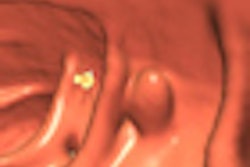CHICAGO - Virtual colonoscopy using a same-day bowel preparation showed high diagnostic accuracy and equally high patient satisfaction in a study from Italy presented on Wednesday at the RSNA 2011 meeting.
The same-day noncathartic bowel prep using iodinated oral contrast had overall excellent image quality and high sensitivity compared to conventional colonoscopy, according to the researchers.
A full cathartic bowel preparation has traditionally been required for both virtual and conventional colonoscopy, but many researchers believe that a more comfortable bowel preparation method could lure more adults to be screened for colorectal cancer. Currently, about half of the eligible screening population ages 50 years and older chooses to avoid testing.
So even though bowel preparation represents a crucial step in virtual colonoscopy (also known as CT colonography or CTC), "we know it also represents the worst part of the examination for patients," said Dr. Franco Iafrate from the University of Rome "La Sapienza." The use of oral iodinated contrast as a noncathartic tagging agent produces excellent tagging without a cathartic prep, but in most parts of the world it's not entirely appropriate, he said.
Sending the patient home to drink the iodinated agent during a multiday tagging protocol "represents a kind of off-label use," Iafrate said. "So the right way to do it is same-day tagging" at the center where VC is being performed, he said, and a one-day prep would presumably make it easier on patients as well.
"The purpose of our work was to evaluate the same-day iodine bowel preparation for CT colonography in asymptomatic and symptomatic patients," he said.
Fifty patients were enrolled in the study -- 23 men and 27 women, ages 41 to 87 years -- who underwent virtual colonoscopy followed by conventional optical colonoscopy within a week of VC.
Before CTC, all patients followed a low-fiber diet for two days, and then ingested two bisacodyl tablets the night before imaging and two more the day of the exam. When patients arrived at the exam facility they were also asked to drink 400 mL of water mixed with 64.5 g of macrogol and simethicone and 70 mL of the iodinated tagging agent iopamidol (Gastromiro, Bracco Diagnostics). The group waited at least 1.5 hours before the CTC exam began. Before the study, patients underwent automated colonic insufflation with CO2 (ProtoCO2l, Bracco). Prone and supine low-dose CTC exams were performed on a 64-detector-row scanner.
The researchers recorded the number of evacuation episodes and the time of the first evacuation after the prep, as well as the number of false-positive detections in both the supine and prone series.
Two independent readers, one with experience in more than 7,000 CTC cases and the other with experience in more than 300, read the images to look for polyps and colorectal cancer. A visual analogue scale (VAS) was administered to all patients to gauge exam tolerability, Iafrate said. The patients were asked to grade the CT exam immediately after it was completed.
Image quality was graded by bowel segment on a scale of 1 to 5, with five being optimal. More than 90% of the segments were graded 5, meaning that the segment was well-tagged without inhomogeneities, Iafrate said. A grade of 4 was reserved for segments with inhomogeneities that were still readily diagnostic. Six percent of segments were rated 4, and the rest were rated 3 in image quality; no segments were graded 1 or 2, he said.
The average number of evacuations at the center was three, and 80% of patients had their first evacuation within an hour after ingesting the same-day prep. The waiting time before CTC ranged from one hour and 45 minutes to two hours and 10 minutes, Iafrate said.
The mean VAS scale result -- patients' grading of the prep and exam process -- was a "very impressive" 9.1 on a scale of 1 to 10, Iafrate said.
Per-patient sensitivity compared to segmentally unblinded optical colonoscopy
|
For detecting clinically significant polyps 10 mm and larger, "the sensitivity reached by reader 1 and even reader 2 was 92%," Iafrate said. "We can say that same-day preparation with iopamidol results in a very high patient acceptability, and comparable image quality and diagnostic performance, compared to standard examination. Tolerability of the exam was very high in 90% of patients," he said.



















